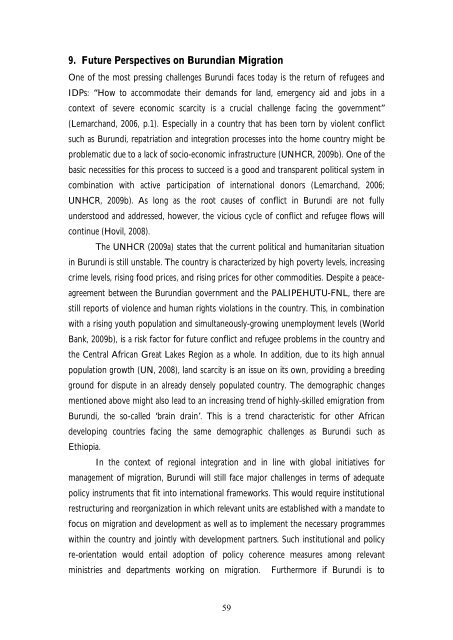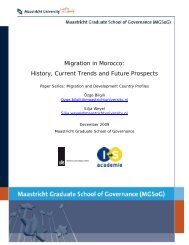Migration in Burundi: History, Current Trends and Future - MGSoG ...
Migration in Burundi: History, Current Trends and Future - MGSoG ...
Migration in Burundi: History, Current Trends and Future - MGSoG ...
You also want an ePaper? Increase the reach of your titles
YUMPU automatically turns print PDFs into web optimized ePapers that Google loves.
9. <strong>Future</strong> Perspectives on <strong>Burundi</strong>an <strong>Migration</strong><br />
One of the most press<strong>in</strong>g challenges <strong>Burundi</strong> faces today is the return of refugees <strong>and</strong><br />
IDPs: “How to accommodate their dem<strong>and</strong>s for l<strong>and</strong>, emergency aid <strong>and</strong> jobs <strong>in</strong> a<br />
context of severe economic scarcity is a crucial challenge fac<strong>in</strong>g the government”<br />
(Lemarch<strong>and</strong>, 2006, p.1). Especially <strong>in</strong> a country that has been torn by violent conflict<br />
such as <strong>Burundi</strong>, repatriation <strong>and</strong> <strong>in</strong>tegration processes <strong>in</strong>to the home country might be<br />
problematic due to a lack of socio-economic <strong>in</strong>frastructure (UNHCR, 2009b). One of the<br />
basic necessities for this process to succeed is a good <strong>and</strong> transparent political system <strong>in</strong><br />
comb<strong>in</strong>ation with active participation of <strong>in</strong>ternational donors (Lemarch<strong>and</strong>, 2006;<br />
UNHCR, 2009b). As long as the root causes of conflict <strong>in</strong> <strong>Burundi</strong> are not fully<br />
understood <strong>and</strong> addressed, however, the vicious cycle of conflict <strong>and</strong> refugee flows will<br />
cont<strong>in</strong>ue (Hovil, 2008).<br />
The UNHCR (2009a) states that the current political <strong>and</strong> humanitarian situation<br />
<strong>in</strong> <strong>Burundi</strong> is still unstable. The country is characterized by high poverty levels, <strong>in</strong>creas<strong>in</strong>g<br />
crime levels, ris<strong>in</strong>g food prices, <strong>and</strong> ris<strong>in</strong>g prices for other commodities. Despite a peace-<br />
agreement between the <strong>Burundi</strong>an government <strong>and</strong> the PALIPEHUTU-FNL, there are<br />
still reports of violence <strong>and</strong> human rights violations <strong>in</strong> the country. This, <strong>in</strong> comb<strong>in</strong>ation<br />
with a ris<strong>in</strong>g youth population <strong>and</strong> simultaneously-grow<strong>in</strong>g unemployment levels (World<br />
Bank, 2009b), is a risk factor for future conflict <strong>and</strong> refugee problems <strong>in</strong> the country <strong>and</strong><br />
the Central African Great Lakes Region as a whole. In addition, due to its high annual<br />
population growth (UN, 2008), l<strong>and</strong> scarcity is an issue on its own, provid<strong>in</strong>g a breed<strong>in</strong>g<br />
ground for dispute <strong>in</strong> an already densely populated country. The demographic changes<br />
mentioned above might also lead to an <strong>in</strong>creas<strong>in</strong>g trend of highly-skilled emigration from<br />
<strong>Burundi</strong>, the so-called ‘bra<strong>in</strong> dra<strong>in</strong>’. This is a trend characteristic for other African<br />
develop<strong>in</strong>g countries fac<strong>in</strong>g the same demographic challenges as <strong>Burundi</strong> such as<br />
Ethiopia.<br />
In the context of regional <strong>in</strong>tegration <strong>and</strong> <strong>in</strong> l<strong>in</strong>e with global <strong>in</strong>itiatives for<br />
management of migration, <strong>Burundi</strong> will still face major challenges <strong>in</strong> terms of adequate<br />
policy <strong>in</strong>struments that fit <strong>in</strong>to <strong>in</strong>ternational frameworks. This would require <strong>in</strong>stitutional<br />
restructur<strong>in</strong>g <strong>and</strong> reorganization <strong>in</strong> which relevant units are established with a m<strong>and</strong>ate to<br />
focus on migration <strong>and</strong> development as well as to implement the necessary programmes<br />
with<strong>in</strong> the country <strong>and</strong> jo<strong>in</strong>tly with development partners. Such <strong>in</strong>stitutional <strong>and</strong> policy<br />
re-orientation would entail adoption of policy coherence measures among relevant<br />
m<strong>in</strong>istries <strong>and</strong> departments work<strong>in</strong>g on migration. Furthermore if <strong>Burundi</strong> is to<br />
59



